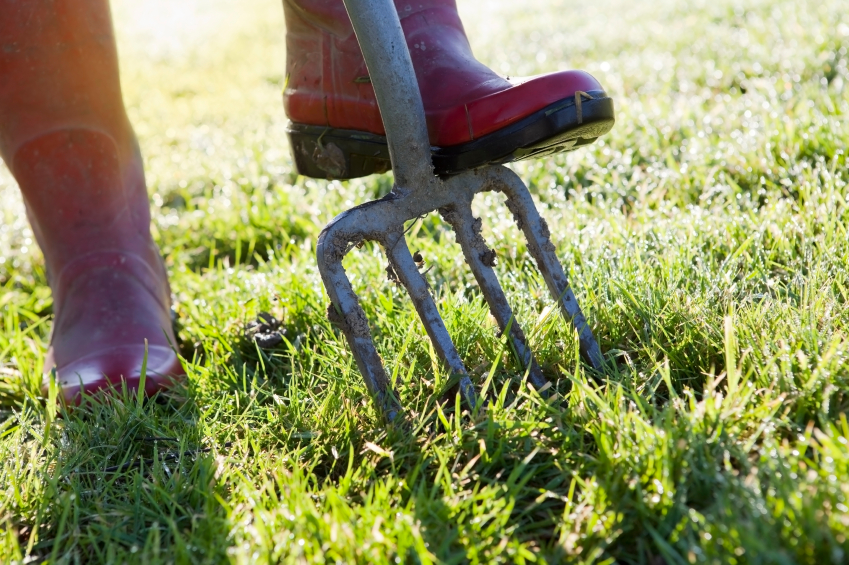Dethatching Your Lawn
 Thatch is that layer of dead plant material in between the soil and the leaves of grass. A healthy lawn should have a thatch layer up to about ½" thick. This benefits grass in much the same way as mulch benefits a garden: holding in moisture, providing nutrients, and yet allowing water and fertilizer to penetrate to the roots. On the other hand, a thatch layer over a ½" is just as detrimental as soil compaction. This will block water, air, and fertilizer from reaching grass roots. It's also unattractive and may encourage fungal disease and pests.
Thatch is that layer of dead plant material in between the soil and the leaves of grass. A healthy lawn should have a thatch layer up to about ½" thick. This benefits grass in much the same way as mulch benefits a garden: holding in moisture, providing nutrients, and yet allowing water and fertilizer to penetrate to the roots. On the other hand, a thatch layer over a ½" is just as detrimental as soil compaction. This will block water, air, and fertilizer from reaching grass roots. It's also unattractive and may encourage fungal disease and pests.
Thatch is a natural part of a lawn's life cycle and, contrary to popular belief, is unrelated to how you deal with your grass clippings. According to Trey Rogers, author of Lawn Geek, “One of the biggest misconceptions I've run across in lawn care is that leaving grass clippings behind after mowing results in excessive thatch buildup. Clippings are 85-90 percent water, and they break down very quickly. Thatch is dead plant stems and roots. Too much thatch indicates that they're not breaking down as quickly as they should, but grass clippings have nothing to do with this process.”
Symptoms of a Thatchy Lawn
If you water your lawn properly and regularly but it seems to remain dry, that's a sign that either the thatch layer is too thick or the soil is too compact. In either case, the water may not be able to reach the roots. Another sign is a lawn that feels overly fluffy to walk on. A lawn should have a certain bounce to it, but too much bounce may be a sign of too much thatch.
The easiest way to tell is to grab a spade and dig up a chunk of grass a few inches deep and take a look at it. If the thatch layer on that sample is more than a half inch thick, then you need to take action. It's time for dethatching your lawn.
Treating Your Thatch
One way to treat the symptoms of a too-thick thatch layer is to aerate the lawn. For a manageable sized lawn, use a manual core aerator (not a spike aerator—these just further compact the soil). For larger lawns, use a power aerator (only if you're in good physical condition, as these machines can be very unwieldy). The aeration will encourage the soil organisms that naturally break down thatch to increase their activity and do what they do best.
Your best option is to dethatch. Rogers recommends dethatching your lawn in late summer or early fall if you have one of the cool-season grass varieties (e.g. bluegrasses, ryegrasses, fescues). “It gives them enough time to recover before cold weather sets in but cuts down on their having to compete with weeds.” The first step in dethatching is to mow the lawn. Rogers suggests mowing low and, in this case, removing the clippings.
Tools to Use
Raking is the most common way to dethatch. There are special rakes made for this job called thatch rakes. They look like lawn rakes on steroids. If this is not available to you, a bamboo rake generally works better than a plastic rake.
Comb the entire lawn with the rake. Regardless of which rake you use, you'll want to go over the lawn at least twice in two different directions. If you have a large lawn, rent a power rake or vertical mower. After, use a leaf rake to rake up the thatch and remove it. Now your grass will be able to thrive again.
After you have dethatched, fertilize and water your lawn. This also an excellent time to reseed patchy areas. Then, just take care of your lawn and it will take care of you.
If you're not up to DIY lawn care, find a professional landscaper to do the job for you.
Updated December 13, 2018.
Looking for a Pro? Call us (866) 441-6648

Landscaping Average Costs
Landscapers Experiences

Tree Removal For The Last Part Of A Poor Old Mulberry

Careful, Professional Tree Service Removes A Huge Norway Maple



